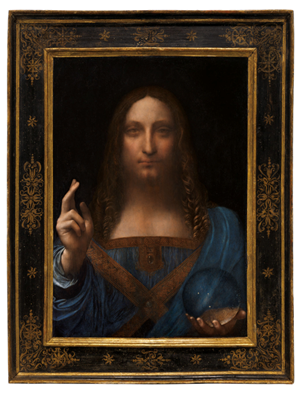
Without question the greatest artistic rediscovery of the 21st century, this singular example of a painting by da Vinci in private hands will be offered as a special lot in the Post-War and Contemporary Art Evening Sale on 15 November at Christie’s in New York.
Without question the greatest artistic rediscovery of the 21st century, this singular example of a painting by da Vinci in private hands will be offered as a special lot in the Post-War and Contemporary Art Evening Sale on 15 November at Christie’s in New York.
‘Salvator Mundi is a painting of the most iconic figure in the world by the most important artist of all time,’ says Loic Gouzer, Chairman, Post-War and Contemporary Art at Christie’s in New York. ‘The opportunity to bring this masterpiece to the market is an honour that comes around once in a lifetime. Despite being created approximately 500 years ago, the work of Leonardo is just as influential to the art that is being created today as it was in the 15th and 16th centuries.’
The newly discovered masterpiece, dating from around 1500, depicts a half-length figure of Christ as Saviour of the World, holding a crystal orb in his left hand as he raises his right in benediction. Leonardo’s painting of the Salvator Mundi was long believed to have existed but was generally presumed to have been destroyed.
What is known for certain is that it belonged to King Charles I (1600-1649), where it is recorded in the inventory of the royal collection drawn up a year after his execution. The royal inventory records that the painting was sold at the ‘Commonwealth Sale’ on 23 October 1651. Nine years later, when Charles II was restored to the throne and his late father’s possessions were recalled by an act of Parliament, the painting was returned to the Crown. A 1666 inventory of the collection of Charles II at Whitehall lists it among the select paintings in the King’s closet.
Leonardo da Vinci, Salvator Mundi (detail)
The painting disappeared from 1763 until 1900 when — its authorship by Leonardo, origins and illustrious royal history entirely forgotten — it was acquired from Sir Charles Robinson, who purchased the picture as a work by Leonardo’s follower, Bernardino Luini, for the Cook Collection, Doughty House, Richmond. By this time, Christ’s face and hair had been extensively repainted. A photograph taken in 1912 records the work’s altered appearance.
In the dispersal of the Cook Collection, the work was ultimately consigned to auction in 1958 where it fetched £45, after which it disappeared once again for nearly 50 years, emerging only in 2005 — its history still forgotten — when it was purchased from an American estate.
Leonardo da Vinci, Salvator Mundi (detail)
In 2007, an extensive restoration of Salvator Mundi was undertaken by Dianne Dwyer Modestini, Senior Research Fellow and Conservator of the Kress Program in Paintings Conservation at the Conservation Center of the Institute of Fine Arts, New York University. Dr. Modestini has extensively documented the painting’s state of preservation and her conservation process, concluding that the painting was indeed an autograph work by Leonardo da Vinci.
As the possibility of Leonardo’s authorship became clear, it was decided to show the painting to a group of international scholars and experts in Leonardo’s works. The painting was viewed by the late Mina Gregori (University of Florence) and Sir Nicholas Penny (then, Chief Curator of Sculpture, National Gallery of Art, Washington, D.C.; subsequently Director of The National Gallery, London). The study and examination of the painting by a panel of international scholars resulted in a broad consensus that Salvator Mundi was painted by Leonardo da Vinci.
Image on top: Leonardo da Vinci, Salvator Mundi. Oil on walnut panel. Panel dimensions: 25 13/16 x 17 15/16 in (65.5 x 45.1 cm) top; 17¾ in (45.6 cm) bottom; Painted image dimensions: 15⅜ x 17½ in (64.5 x 44.7 cm). Estimate $100 mln.

ArtDependence Magazine is an international magazine covering all spheres of contemporary art, as well as modern and classical art.
ArtDependence features the latest art news, highlighting interviews with today’s most influential artists, galleries, curators, collectors, fair directors and individuals at the axis of the arts.
The magazine also covers series of articles and reviews on critical art events, new publications and other foremost happenings in the art world.
If you would like to submit events or editorial content to ArtDependence Magazine, please feel free to reach the magazine via the contact page.